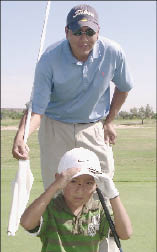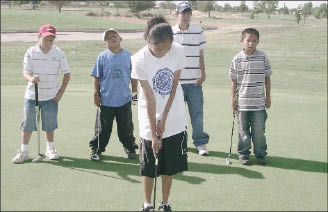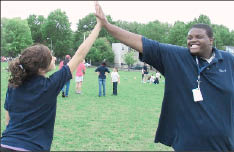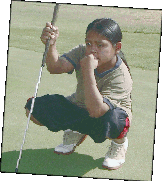 |
|
Putting in time: Instructor Kevin Price teaches Trey Benally, 7, about how to read putts, as part of the NB3 Junior Golf Program.
Photo: Notah Begay III Foundation |
Sports seems to be a natural avenue to youth development, especially for leadership skills, because kids naturally gravitate toward physical activity and competition. But using sports to reach at-risk youths is a lot tougher than it appears.
“The mistake we make is [to believe] that sports builds character. In and of itself, it doesn’t,” says Don Hellison, professor in the College of Education at the University of Illinois at Chicago and co-author of Youth Leadership in Sport and Physical Education. Hellison says sports is a good medium because kids like it, but there has to be more to it.
His co-author Tom Martinek, professor in the Department of Kinesiology at the University of North Carolina Greensboro, agrees. “You have to have a set of core values that drives what you do,” he says. “The program has to teach kids life skills, not just sports skills.”
Why Teens Make Good Leaders
Hellison says a key to teaching kids to be leaders through sports is to eliminate the emphasis on winning. Instead, he suggests showing youths how to work with other kids in the community or showing them how to plan a lesson and then teach it to others.
That’s what Project Coach in Springfield, Mass., does. “In most communities, teenagers are looked at as vulnerable and as threats,” says Sam Intrator, co-project director for Project Coach. “We see them as inspired assets.” This is especially true in the north end of Springfield, where impoverished communities lack the parent volunteers to run sports programs for children. That’s why Intrator and fellow Smith College (Northampton, Mass.) professor Don Siegel decided to turn the community’s teenagers into coaches to have them to fill the shoes normally filled by adult volunteers. Their program teaches at-risk teens to lead younger children through participation in basketball and soccer.
“Teenagers have traction with younger kids in the coaching world,” Intrator says. “And leading kids naturally builds self-esteem for them.”
Teenagers participating in Project Coach receive salaries, and Intrator says making it a paying job is part of the strategy. “Our coaches feel professional,” he says. “They’re getting paid, and they’re making a tremendous time commitment.”
What Works
“Teenagers want to be on that horse,” says Patricia Broersma, who runs the Transformational Adventures with the Horse program in Ashland, Ore. “But we start with the groundwork first.”
For Broersma, that means working with youngsters on identifying the obstacles that stand in their way and then symbolically conquering those obstacles through increasing skill in horsemanship.
Intrator says it’s also important when trying to teach kids leadership through sports to give them a very real opportunity to lead. “Whether you’re doing sports or theater, what really works is when you work together, not in a hierarchy,” he says.
Broersma says she finds that a big part of teaching leadership is showing youths they can control their own destinies. She works with teens from a residential treatment facility and tries to create an environment in working with horses that encourages kids to see their lives as an adventure they must work their way through. “They start seeing themselves as in charge of their own stories,” Broersma says.
Kids can also be inspired when they are provided with something to which they wouldn’t normally have access. The Notah Begay III Foundation (NB3) in Albuquerque, N.M., for example, gives Native American youth on severa; nearby reservations the chance to play and develop skills in golf. “Golf can be a hard game to sell, because it’s very expensive,” Notah Begay Jr., head coach for the foundation’s Junior Golf Program, says. But when kids see the opportunity to be like Notah Begay III, a PGA pro, they want to be a part of it. “It’s not common for a full-blooded American Indian to be a pro golfer,” says Begay of his son.
Both NB3’s Junior Golf Program and Project Coach make use of a process of ongoing personal evaluation, through which kids analyze how they have performed. Hellison says this is central to making sports a leadership tool. “Have the kids self-evaluate at the end of the day,” he says. “Did you make this a better program today?”
Get Connected
As with any youth program, community connections are important to success. Project Coach has developed close working relationships with schools in Springfield, as well as local community organizations, and relies on both for recruits and for space to conduct its programs. “We’re very embedded in the community,” Intrator says.
The NB3 foundation has a strong relationship with To’Hajiilee High School on the Laguna Pueblo, which the golf program serves. The school provides uniforms and transportation. At the same time, the golf program requires participants to maintain passing grades in school. Program leaders say it helps youths develop the skills they need to build better lives. “A lot of kids on the reservations fall off the map after they graduate,” says Begay. By partnering with the school system, Begay hopes to inspire more Native American students to reach for higher goals, just as his son has.
Martinek says sports can be a great way to level the playing field for at-risk kids. “They get to experience a leadership role in a program,” he says. “These kids don’t usually have a lot of opportunity for leadership in school.”
“If you ask a teenager to lead and give them structure to do so, they can do remarkable work,” says Intrator.
Deborah Huso is a freelance writer based in Blue Grass, Va.
Transformational Adventures with the Horse
Ashland, Ore.
(541) 890-6376
The Strategy: Teach first-time youth offenders leadership skills through interactions with horses.
Getting Started: Patricia Broersma, immediate past president of the Equine Facilitated Mental Health Association,began offering equine therapy programs to troubled teens about 20 years ago. Although she previously worked with at-risk youth, she now works primarily with residents of the Lithia Springs Residential Treatment Center, which houses adjudicated juveniles, many of whom have had drug problems.
How It Works: Broersma’s program is somewhat unusual in that it works with kids through the concept of the “Hero’s Journey.” Broersma teaches youths from the treatment center that they are on a journey, much like Harry Potter, where they have to go through an adventure in order to reach a higher calling. She shows them how to see their time at the treatment center as part of a journey of inner growth.
“My program is oriented toward helping kids discover their inner capacities,” says Broersma. “We define leadership as calling a horse into partnership.” At present, Transformational Adventures is available as a 10-week summer program and as a weekend program. Teens not only learn how to work with and ride horses but also are asked to analyze their interactions with the horses.
“The same horse reacts differently with different people,” Broersma says. “Horses teach kids the subtleties of communication, and we teach them to apply that same sensitivity elsewhere. We teach leadership skills by teaching kids to use their bodies and their inner resources.”
Youth Served: The program serves about 30 kids a year from the residential treatment center, most between the ages of 12 and 20.
Staff: Broersma has another riding instructor who assists her, along with four volunteers.
Money: Broersma says it costs about $5,000 per youth to run the summer program; she usually tries to run three summer programs with eight kids each. The program receives funding from local banks and service clubs and through a private family trust.
Results: Like many equine therapy programs, Transformational Adventures has not had any formal evaluations. Broersma says staff members at the residential treatment center where the teens reside have said youths participating in equine therapy often show an immediate increase in energy levels and changes in how they relate to others; they note the youths become more attentive to people and even treat the cats at the center better.
NB3 Junior Golf Program
Notah Begay III Foundation
Albuquerque, N.M.
(505) 362-4507
http://www.notah.com
The Strategy: Teach Native American youth leadership skills through golf instruction and exposure to golf etiquette.
 |
| Photo: Notah Begay III Foundation |
In focus: Theresa Pablo, 14, goes through a putting drill; Ryan Tso, 9, watches and learns from another youth.
Getting Started: The Notah Begay III (NB3) Foundation’s Junior Golf Program started in 2000 with an initial $20,000 grant from the United States Golf Association (USGA). Professional Golfers Association golfer Notah Begay III initiated the program in an effort to give back to his native Laguna Pueblo community and expose Native American youth, most of them impoverished, to sports to which they would not otherwise have access.
How It Works: The program operates on two levels: a summer program available to youth ages 10 and up and a school year program (running in fall and spring) at To’Hajiilee High School, which is open to youths in grades eight through 12 who have graduated from the summer program. In addition to receiving instruction in the game of golf from the pro golfer’s father, Notah Begay Jr., and assistant coach Jerry Johns, youths also receive intensive instruction in golf etiquette, separate from their work on the course.
“The biggest difference between our program and other junior golf programs is that we isolate the etiquette,” says the elder Begay. Youths learn proper attire for the golf course, manners, how to win and lose gracefully, how to be thankful, and how to look people in the eye and communicate effectively. “These are all life skills,” Begay says. “We’re trying to use golf as a tool to build character and self-esteem and to teach kids to challenge themselves.”
When youths are on the course playing, instructors evaluate their game etiquette, and afterward they gather as a group to discuss interactions on the course – what was working and what needed to be improved. “We make the kids analyze what they do,” says Begay, which he considers a steppingstone to leadership qualities.
Youth Served: The program currently serves 80 to 100 Native American youths annually, ranging in age from 10 to 18. Most are from the Laguna Pueblo reservation west of Albuquerque, although the program has gradually expanded to include Native American youths living in the city and youths from other area reservations.
Staff: The three paid staff members are Begay, an assistant coach who also serves as bus driver, and an etiquette instructor. Pros from area golf courses also provide instruction as volunteers.
Money: The NB3 Junior Golf Program operates on an annual budget of $25,000 to $30,000, most of which comes from the program’s own fundraising drives. It also receives donations and gets some supplies at cost from Nike and Callaway.
Results: There have been no formal evaluations, though the foundation plans to begin formal evaluations this year, with the help of Johns Hopkins University. Begay says he has seen a decrease in gang recruitment and activity on the reservation since the golf program began and has also seen kids become excited about playing golf in town, rather than always remaining on the reservations.
Project Coach
Smith College
Northampton, Mass.
(413) 585-3242
(413) 585-3977
http://www.smith.edu/educ/projects/projectcoach.php
The Strategy: Teach leadership and personal development skills to teens by training them to be soccer and basketball coaches to elementary school students.
 |
|
Reaching higher: Koby Altman, right, assistant coach of Amherst College’s basketball team, with a student coach. Amherst conducts a coaching workshop as part of the Project Coach Academy.
Photos: Project Coach

|
Getting Started: Project Coach evolved out of research conducted by Smith College Professor of Exercise and Sports Studies Don Siegel, who was studying how out-of-school time spent specifically in sports impacted academic achievement. He and co-project director Sam Intrator, professor of education and child study at Smith, decided to start a program in which teenagers would be trained as sports coaches and then sent out into their communities to teach soccer and basketball to elementary school students. The program started in the 2004-05 school year in Holyoke and North Springfield.
How It Works: Teens apply to participate in the program (often after being recruited through their high schools or community organizations), undergo an intensive interview process requiring recommendations, and then go through three weeks of training in the Project Coach Academy. They learn how to teach soccer and basketball, how to lead young people, how to engage in teamwork and how to conduct conflict resolution. They also learn the basics of child development.
During the school year, the teen coaches teach soccer in the fall and basketball in the winter and spring to elementary school students in north Springfield. On Mondays, the coaches have preparatory classes with the project co-directors and graduate student participants on specific skills relative to coaching, such as how to stem a conflict between team members. They role-play and rehearse how to handle situations. On Tuesdays and Wednesdays, they coach their individual teams after school at elementary school gyms or affiliated soccer fields. On Thursdays, the teen coaches meet for instruction in health and wellness and applying their coaching skills to life in a broader way, from how they conduct themselves in their communities to how they interact with friends and family.
Youth Served: Project Coach trains about 25 teen coaches a year who, in turn, coach about 120 elementary school students in their own neighborhoods. Most of the student athletes live in the north end of Springfield, which has a poverty rate of about 60 percent.
Staff: Intrator and Siegel head the program and rely on the assistance of about five graduate students, who are themselves responsible for overseeing the work of four to five teen coaches.
Money: Project Coach pays the student coaches minimum wage and costs about $90,000 a year to run. These costs do not include about $200,000 in tuition waivers for graduate students who work in the program. Funding is provided through Smith College and the New North Citizens Council, Global Sport Foundation, National Basketball Association, MassMutual Foundation, and the Irene E. & George A. Davis Foundation.
Results: Project Coach has used several evaluative surveys to determine the impact on youth. On the three occasions Project Coach administered the Development Asset Profile, they found statistically significant improvements in coaches’ commitment to learning, positive values, social competencies, positive identity, support, empowerment, boundaries and expectations, and constructive use of time between beginning of the program in the fall and the subsequent spring sports seasons. Anecdotally, Siegel says the teens are developing superb cognitive skills, including the ability to inspire others and engage in strategic thinking. “If we can hone these skills in Project Coach, then kids can transfer them to their schools and communities,” he says.





























